Urban Fugitive Dust Policy
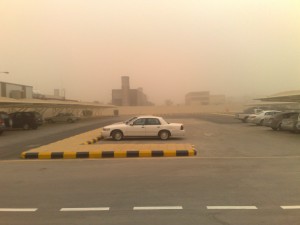 BCAA adopted this policy in -1996 as a result of a Memorandum of Agreement (MOA) among EPA, Washington State Department of Ecology and BCAA. This policy was developed after 18 months of stakeholder meetings, drafts and revisions.
BCAA adopted this policy in -1996 as a result of a Memorandum of Agreement (MOA) among EPA, Washington State Department of Ecology and BCAA. This policy was developed after 18 months of stakeholder meetings, drafts and revisions.
The main requirement of the MOA was accounting for PM10 NAAQS exceedances as windblown dust events, not man-made. The Tri Cities urban MOA was parallel to Columbia Plateau PM10 Project which explained the regional nature of windblown PM10.
The policy describes how BCAA interprets and enforces 173-400-010(9)(a) in urban areas of Benton County.
Fugitive Dust
(9) Fugitive dust.
(a) The owner or operator of a source of fugitive dust shall take reasonable precautions to prevent fugitive dust from becoming airborne and shall maintain and operate the source to minimize emissions.
(3) Fallout. No person shall cause or allow the emission of particulate matter from any source to be deposited beyond the property under direct control of the owner or operator of the source in sufficient quantity to interfere unreasonably with the use and enjoyment of the property upon which the material is deposited.
This policy defines “reasonably available control methods” for fugitive dust control, and describes BCAA’s enforcement program.
This policy also provides relief to citizens and contractors if the wind speed exceeds a threshold – but only if all reasonably available means of dust control are already in place.
More information on preventing windblown dust is here.
Exceptional Events
As we are all aware, Benton County is occasionally subject to wind and dust storms. These storms can cause the PM concentrations in the air to become unhealthy, and to exceed the National Ambient Air Quality Standards. Along with Ecology, EPA and WSU, research has been done and agricultural and other practices implemented in the last several years so that the dust storm frequency has decreased since the early 90s.
Dust storms can still happen, however, and the BCAA reacts to them according to the Natural Events Action Plan 2003 described below.
Here is a satellite photo of an event that affected our area in
BCAA must provide public notice should ambient PM levels begin to reach health-impact thresholds during a high wind event. BCAA must also gather meteorological and other data and provide event documentation to the EPA.
This action policy, and the documentation is important for two reasons:
Protection of public health is a central part of the mission of the Clean Air Act and BCAA.
If any area exceeds pollution concentrations defined by the National Ambient Air Quality Standards, or NAAQS. more frequently than is permitted by the rule, the area is put into “non attainment”. The non attainment status has significant planning and possibly economic impacts to that area. Since the policy does require that dust originating from man-made sources be controlled according to a best practice, documenting that essentially “nothing more could have been done” to prevent the exceedance avoids a determination of non attainment.
Introduction
During the late 1980s and early 1990s a large number of exceedance of the 24-hour National Ambient Air Quality Standard (NAAQS) form particulate matter ten microns or less (PM10) were recorded in Spokane, Kennewick, and Wallula, Washington. An examination showed a close correlation to high wind events. The exeedances are primarily attributable to activity on agricultural fields, although other sources may contribute.
The Columbia Plateau is subject to frequent high winds, particularly during the spring, summer and fall. The Columbia Plateau has a winter precipitation pattern. Topography plays a role since the area closest to the Cascade Mountains has a very low annual rainfall. Low rainfall along with high temperatures causes the soil moisture to evaporate far faster than incoming rain.
The type of soil also plays a part. The Columbia Plateau soils are silty to fine and sandy and have a very weak soil structure. Once it is broken down by tillage, planting, or traffic, it will not form or re-form clods and is very susceptible to wind erosion. This erosion can be worse when the soil has no surface cover, and has been mechanically disturbed.
The Columbia Plateau PM10 Project
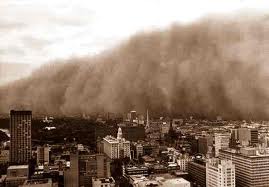 Information about the Columbia Plateau PM10 Project is here. The Columbia Plateau is a 50,000 square mile region in Washington, Oregon, and Idaho containing both one of the driest as well as the most productive rainfed wheat regions in the world. Windblown dust is a concern in the dryer regions of the Columbia Plateau; dust generated from farming and construction sites poses a hazard to motorists, reduces soil productivity, and pollutes air in downwind communities.
Information about the Columbia Plateau PM10 Project is here. The Columbia Plateau is a 50,000 square mile region in Washington, Oregon, and Idaho containing both one of the driest as well as the most productive rainfed wheat regions in the world. Windblown dust is a concern in the dryer regions of the Columbia Plateau; dust generated from farming and construction sites poses a hazard to motorists, reduces soil productivity, and pollutes air in downwind communities.
Since 1993, a multi-disciplinary team of scientists has worked to provide significant insight and quantification on wind erosion and dust emissions from farm fields and the potential impacts to people living downwind. We have tested and verified a number of potential farm management and cropping system options to control wind erosion. Our field research has shown that some control practices are clearly not agronomically and economically viable, whereas other practices can be put to use to benefit our soil resource and air quality without hardship to the livelihood of farmers. The project continues to identify or develop sustainable practices that will reduce dust emissions from agricultural soils as well as to develop the capabilities to predict blowing dust events. As a result, decisions by farmers and agencies are being made from solid science.
The work of the Columbia Plateau Project has supported and continues to inform efforts to minimize windblown dust in Benton County.
Description of the EPA’s Exceptional Events Policy
The policy addresses PM-10 National Ambient Air Quality (NAAQS) violations caused by natural events. In the Columbia Basin these exceedances are caused by high wind.
This policy applies at the time the State determines that a PM-10 NAAQS has been violated due to natural events and addresses the question of what should be done to protect public health.
The guiding principles followed in developing this policy are:
1. Protection of public health is the highest priority of Federal, State, and local air pollution control agencies.
2. The public must be informed whenever the air quality in an area is unhealthy
3. All valid ambient air quality data should be submitted to the EPA Aerometric Information Retrieval System (AIRS) and made available for public access.
4. State and local agencies must take appropriate reasonable measures to safeguard public health regardless of the source of PM-10 emissions.
5. Emission controls should be applied to sources that contribute to exceedances of the PM-10 NAAQS when those controls will result in fewer violations of the standards.
Definition of PM-10 Natural Events caused by High Wind High Winds:
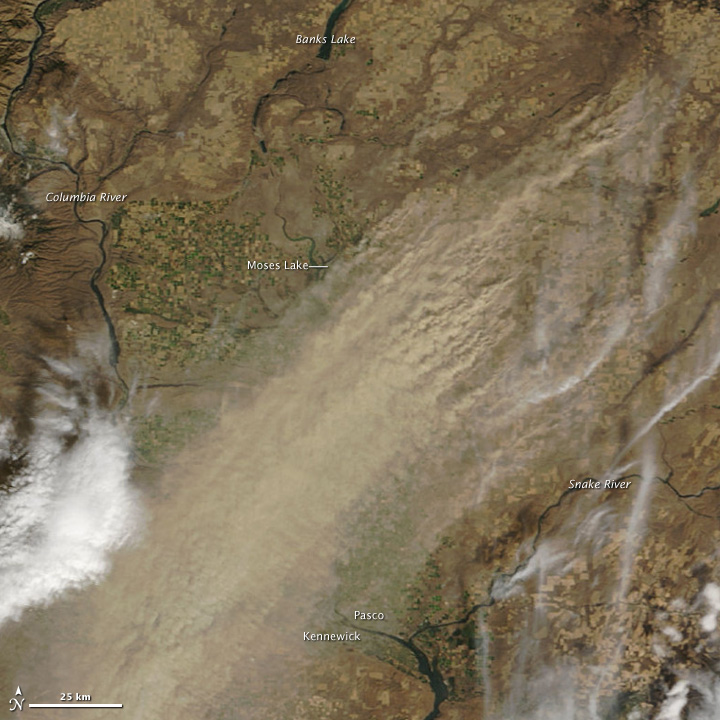 Ambient PM-10 concentrations due to dust raised by unusually high winds will be treated as due to uncontrollable natural events under the following conditions:
Ambient PM-10 concentrations due to dust raised by unusually high winds will be treated as due to uncontrollable natural events under the following conditions:
(1) the dust originated from non man-made sources, or
(2)the dust originated from man-made sources controlled with best available control measures (BACM)
This definition means that in order to be “excused” as a NAAQS exceedance, agriculture, businesses, and individuals must already be using control measures for windblown dust.
Here is a copy of Washington State’s Exceptional Events Plan is Natural Events Action Plan 2003
A dust storm occurred in March of 2004. Natural Events documentation was developed for submittal to the EPA. A copy of that document is March 18. 2004 Event
Dust Control
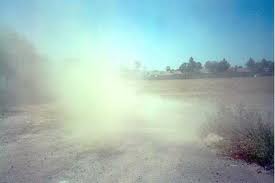 Property owners are responsible for controlling dust from their property according to the Washington Administrative Code 173-400-040 paragraph 9.
Property owners are responsible for controlling dust from their property according to the Washington Administrative Code 173-400-040 paragraph 9.
Fugitive Dust Policy
In 1995, the Clean Air Agency established a committee to determine a policy for the enforcement of dust regulations in the urban areas. Dust that moves off of property and impacts others is called “fugitive dust” and is regulated by state law. The committee was composed of community members including health officials, agriculture, construction industry, government officials, and other community members. The final draft of the policy was put into effect in June 1996.
A copy of the Urban Fugitive Dust Policy PDF is available here
Dust Control Guidelines
Reasonable Control Measures for many situations listed below can be found here:
- construction and demolition
- managing vacant lots
- piles of material
- hauled material
- roads
- California AIr Quality Resources Board (CARB) List of Measures to Reduce PM10 and PM2.5
- USDA Dust Palliatve Selection and Application Guide
Dust Control Plans
The BCAA also has guidelines and forms for submitting a dust control plan (PDF DOC). Although we typically do not require dust control plans, these guidelines are useful for planning so that your project does not create a dust nuisance. BCAA can assist you with dust control strategies and plans.
Warning Letters and Notices of Violation
If you have received a warning letter or Notice of Violation, it most likely is a result of a complaint or complaints from neighbors or other individuals.
Please click here for more information on what to do if you have received either document.
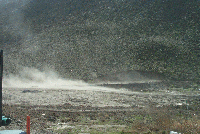

Windblown Dust
The Tri-Cities are located in the most arid part of Washington State. In fact, the annual rainfall of 6-8 inches is drier than most parts of Arizona. Because of the combination of climate, soil conditions, and human interaction with the land, dust is often an inevitable result.
Ecology’s Webpage on Outdoor Dust is here. This page includes information on health effects, monitoring and what you can do to protect yourself in the event of dust events.

Windblown dust is common where soil has been disturbed. Weather conditions, the natural environment, and human activities can cause windblown, construction, or fugitive dust which contributes to air pollution. High winds can raise large amounts of dust from areas of dry, loose, or disturbed soil.
Outdoor dust can come from:
- Windblown dust
- Tilled, harvested, and fallow farm fields
- Natural areas during highest winds
-
Construction dust
- While work is underway
- Cleared and vacant land
-
Fugitive dust
- Paved and unpaved roads
- Activities on vacant land or disturbed areas
- Unpaved parking lots and equipment yards
- Military training exercises
There is dust moving off my property, what should I do about it?
The WAC governing fugitive dust is here, paragraphs 3 and 9a.
Throughout Washington State, it is the responsibility of the owner or operator of a source of dust to ensure that dust does not move off property to impact others. WAC 173-400-040 (9)(a) states that:
“The owner of operator of a source of fugitive dust shall take reasonable precautions to prevent fugitive dust from becoming airborne and shall maintain and operate the source to minimize emissions.”
Sources of fugitive dust are required under this regulation to control the movement of dust off their property. The BCAA Urban Fugitive Dust Policy (FDP) is an available resource for providing owners and operators information of methods for controlling fugitive dust. These methods are called “reasonable precautions.” It is in the best interest of the owners and operators to control the fugitive dust on their property by being familiar with the FDP and with the applicable State and local regulations. If there are no precautions taken and dust impacts others, the BCAA can take enforcement actions with penalties up to $10,000 per day.
For those that are being impacted by dust from sources, complaints can be made to the BCAA office. The information needed is the complainant’s name, daytime phone number, the name of the site, owner, or contractor, and any other descriptive information about the situation. This will later help the BCAA to identify and contact the source owner or operator.
If the BCAA has not received any complaints about the source in the past, the Inspector will issue a warning letter outlining the regulations to the owner or operator of the source. If previous complaints have been received the Inspector may issue a Notice of Correction (NOC) or a Notice of Violation (NOV). The NOC outlines a specific list of requirements that the source must take to avoid a penalty. The NOV is essentially a ticket for violating the fugitive dust regulation.
I am being impacted by dust and it is causing property damage or creating a health problem. What can I do about it?
Throughout Washington State, it is the responsibility of the owner or operator of a source of dust to ensure that dust does not move off property to impact others. WAC 173-400-040 (9)(a) states that:
“The owner of operator of a source of fugitive dust shall take reasonable precautions to prevent fugitive dust from becoming airborne and shall maintain and operate the source to minimize emissions.”
In order do begin the enforcement process, it is very important that the BCAA receives a complaint for the person being impacted. This complaint will help the BCAA to identify and contact the source owner or operator. Upon receiving your complaint, one of the BCAA Inspectors will contact the owner or operator of the source of dust. In many cases, contact by the BCAA will encourage the source owner or operator to control the dust. Once the source owner or operator has been informed on the regulations and has chosen not to follow them, the BCAA can increase enforcement efforts. If previous complaints have been received the BCAA may issue a Notice of Correction (NOC) or a Notice of Violation (NOV). The NOC outlines a specific list of requirements that the source must take to avoid a penalty. The NOV is essentially a ticket for violating the fugitive dust regulation. Penalties of up to $10,000 per day can also be assessed.


